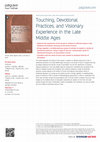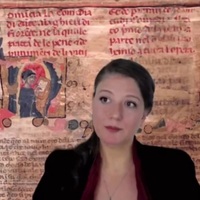Books by Pablo Acosta-García
Revista de Poética Medieval, 2024
Towards a new edition of the «Dialogo» of Catherine of Siena. This volume collects the papers of ... more Towards a new edition of the «Dialogo» of Catherine of Siena. This volume collects the papers of the discussants involved in the 16th Seminar of history and theology of mistics «Claudio Leonardi», held in Rome at the Pontificia Università S. Tommaso d'Aquino («Angelicum»), 2-3 December 2021. Papers by P. Acosta-García, A. Bartolomei Romagnoli, E. Berti, A. Diriart, N. Estrafallaces, G. Festa, C. Lagomarsini, S. Nocentini, N. Pigini, F Santi, C. Tesson, P. Tylus.

Touching, Devotional Practices, and Visionary Experience in the Late Middle Ages, 2019
This book addresses the history of the senses in relation to affective piety and its role in devo... more This book addresses the history of the senses in relation to affective piety and its role in devotional practices in the late Middle Ages, focusing on the sense of touch. It argues that only by deeply analysing this specific context of perception can the full significance of sensory religious experience in the Late Middle Ages be understood. Considering the centrality of the body to medieval society and Christianity, this collection explores a range of devotional practices, mainly relating to the Passion of Christ, and features manuscripts, works of devotional literature, art, woodcuts and judicial records. It brings together a multidisciplinary group of scholars to offer a variety of methodological approaches, in order to understand how touch was encoded, evoked and purposefully used. The book further considers how touch was related to the medieval theory of perception, examining its relation to the inner and outer senses through the eyes of visionaries, mystics, theologians and confessors, not only as praxis but from different theoretical points of view. While considered the most basic of spiritual experience, the chapters in this book highlight the all-pervasive presence of touch and the significance of ‘affective piety’ to Late Medieval Christians.

Primera traducción al español anotada y filológicamente revisada del "Memoriale" de Ángela de Fol... more Primera traducción al español anotada y filológicamente revisada del "Memoriale" de Ángela de Foligno, una de las primeras voces femeninas que podemos leer en Occidente.
Texto de la contraportada:
"El Memorial o Libro de la Vida de Angela de Foligno (1242-1308) constituye una de las obras más importantes de la mística europea medieval. A pesar de no haber sido escrito por esta mujer analfabeta, una terciara franciscana de la Umbria, sino dictado a su guía espiritual, resuena su voz potente para expresar una experiencia inefable, una peregrinación que se inicia con su desnudamiento ante la cruz, según el ideal de pobreza de las nuevas corrientes espirituales, para concluir en el punto sublime de conciliación de los contrarios. Precursora de los grandes maestros de la mística renana como el Maestro Eckhart, su relato cautivó, entre otros muchos, a Georges Bataille que la bautizó como “Dama de la Noche”.
«Quien busca está consigo y así se posee, pero a la vez le falta algo, puesto que se pone a busca... more «Quien busca está consigo y así se posee, pero a la vez le falta algo, puesto que se pone a buscar» (Espejo, p. 148).
Journal articles by Pablo Acosta-García
Medieval Sermon Studies, 2014
This first edition presents a critical text of The Sermon on the Trinity by the visionary Francis... more This first edition presents a critical text of The Sermon on the Trinity by the visionary Franciscan abbess Juana de la Cruz (1481–1534), accompanied by a philologically rigorous transcription and an English translation a fronte. The introduction situates Juana de la Cruz within the broader context of medieval female preachers, examining her unique contributions to the theological and spiritual discourses of her time. By addressing both her visionary experiences and the socio-religious constraints on female preaching, this work sheds new light on Juana’s role as a pioneering voice in late medieval Christianity.

Revista de Poética Medieval, 2024
Introducción al número monográfico de la Revista de Poética Medieval "IMAGEN, PALABRA Y PERFORMAN... more Introducción al número monográfico de la Revista de Poética Medieval "IMAGEN, PALABRA Y PERFORMANCE: NUEVAS PERSPECTIVAS PARA EL ESTUDIO DE LAS SANTAS VIVAS EN LA BAJA EDAD MEDIA CASTELLANA". En el panorama literario hispánico sigue siendo difícil abordar las figuras de Teresa de Jesús y Juan de la Cruz desde el punto de vista de su tradición europea. La percepción de su obra como culmen de la literatura mística del Siglo de Oro proyecta aún hoy una alargada sombra que tiende a presentarla como un unicum de la cultura castellana. Sin embargo, como ponen en evidencia los estudios sobre los movimientos de reforma, la transformación de la vida carmelita promovida por Juan y Teresa, en la que su obra se integra en gran parte, no es una excepción, sino una constante en el seno del cristianismo (Bataillon 1996 [1937], Mixson/Roest, 2015; Mazzonis 2022). Los estudios que se han realizado en las últimas décadas sobre mística europea (en particular, aquellos sobre mística femenina) muestran un panorama complejo, donde abunda una diseminación transnacional de escritos, ideas y prácticas, que desdibuja la imagen monolítica e idealizada de estos dos autores, y que propone, además, un boom anterior de la mística castellana femenina, en el siglo xv (Sanmartín Bastida 2012; Graña Cid 2014; McGinn 2017). En 1990, Gabriella Zarri publicó un influyente libro monográfico que incluía la definición de un nuevo paradigma: el de las santas vivas...
Hipogrifo. Revista de literatura y cultura del Siglo de Oro. , 2022
In this article I conduct a comparative analysis between some of the
sermons of the Libro del con... more In this article I conduct a comparative analysis between some of the
sermons of the Libro del conorte, which textualizes part of the ecstatic preaching of the Franciscan abbess Juana de la Cruz (1481-1534), and some of the public or semi-public revelations of Elisabeth von Schönau (1129-1164/1165). Despite the years separating their work, I study in depth a series of characteristics shared by both visionaries: prophetism as one of the two possibilities of medieval female preaching, liturgy as the cause and collective setting of revelation and, finally, vision as a form of biblical exegesis. This allows me to define a chronological and theoretical frame of reference that will permit the study of female preaching as a European tradition in the near future.
Revista de literatura medieval, 2022
In this article new codicological data from the manuscript Royal Library of the Monastery of San ... more In this article new codicological data from the manuscript Royal Library of the Monastery of San Lorenzo de El Escorial J-II-18, which contains the visionary sermons of the Franciscan abbess Juana de la Cruz (1481-1534), are presented and analyzed. The finding of former library call numbers, the examination of the paper watermarks, and an in-depth study of the binding provides with new perspectives on the apocryphal nature of the prologue.

Studia Aurea, 2021
In the following pages I provide a Philological edition of five unpublished songs linked with the... more In the following pages I provide a Philological edition of five unpublished songs linked with the production of the Franciscan abbess Juana de la Cruz (1481-1534). I study first the source from a material point of view, and then develop a metric analysis of thesongs, putting them in the context of the Franciscan lyrical poetry at a European level. On the other hand, I make a brief theological commentary of each of the songs, contextualizing them in the visionary preaching activity of the abbess.
Resumen: En las siguientes páginas edito y comento un corpus inédito de cinco canciones vinculadas a la abadesa franciscana Juana de la Cruz (1481-1534). Además de un texto que se transcribe siguiendo criterios filológicamente fiables, proporciono una descripción material de la fuente y realizo un estudio métrico de las composiciones. Por otro lado, desde la ladera de su interpretación histórica, hago un breve comentario teológico de cada una de las piezas, que las propone como parte de la producción lírica franciscana europea, a la vez que las contextualizo en la predicación visionaria de la abadesa en su contexto cisneriano. Palabras clave Juana de la Cruz; reforma observante; franciscanismo femenino; predicación femenina; Libro del conhorte; lírica religiosa; laude.

Journal of Medieval Iberian Studies, 2021
This article introduces the “Catalogue of Living Saints,” a wiki catalogue that provides knowledg... more This article introduces the “Catalogue of Living Saints,” a wiki catalogue that provides knowledge about the lives of Castilian charismatic women, prior to Teresa of Ávila (d. 1582), who acquired reputations for holiness in their own times. The lives of these “holy” women show great contact between court and convent, and they contribute to better understanding the history of women and their subsequent impact on society. The collected lives appeared in a diversity of sources: manuscripts of the fifteenth through seventeenth centuries, including conventual books and compendia ontaining lives of saints, handwritten and printed chronicles of religious orders in sixteenth- and seventeenth-century Castile, and other works. Thus, the Catalogue recovers several texts that have never been printed before and that in most cases were never edited independently. Furthermore, it integrates the development of a database in order to
understand the different proposed hagiographical models and their performative shape and spatial distribution of power. Additionally, this article discusses how gathering, editing, and reading the lives of these women via an open-access virtual tool creates a new hermeneutical framework regarding the materiality of the original codices and printed volumes. Finally, it proposes mitigation measures in the near future to bring contemporary reading practices (and interpretation) closer to historical ones.

Religions, 12(3), 223, 2021
In this article, I study in depth the first vita of the Franciscan Tertiary abbess Juana de la Cr... more In this article, I study in depth the first vita of the Franciscan Tertiary abbess Juana de la Cruz (Vida y fin de la bienaventurada virgen sancta Juana de la Cruz, written c. 1534), examining it as a chronicle that narrativizes the origins and reform of a specific religious community in the Castile of the Catholic Monarchs. I argue that Vida y fin constitutes an account that was collectively written inside the walls of the enclosure that can help us understand themes, motifs, and symbolic Franciscan elements that were essential for the self-definition of its original textual community. I first discuss the narrative of the convent’s foundation and then examine the penitential identity of the community, highlighting the inspiration that Juana’s hagiography takes from the infancy of Caterina da Siena, as described in the Legenda maior by Raimondo da Capua, and analyzing to what extent the represented penitential practices related to the imitatio Christi reflect a Franciscan Tertiary identity in opposition to a Dominican one. Finally, I address the passages in which the hagiographer(s) discuss(es) the sense of belonging to the Franciscan order rather than the Dominicans, and the mystical figure of Francesco d’Assisi as a founder, guide, and exemplar.

Archivio italiano per la storia della pietà, XXXIII, 143-172, 2020
Open Access: DOI: 10.5281/zenodo.4580499
A Summary in English by Camila Walls Castillo: https://o... more Open Access: DOI: 10.5281/zenodo.4580499
A Summary in English by Camila Walls Castillo: https://othersisters.hypotheses.org/239
In this article I gather the lives of a group of Castilian sante vive from the 15th and 16th centuries (María de Ajofrín, Juana de la Cruz and María de Santo Domingo and others) and establish a detailed hagiographic comparative analysis which takes into account some previous and contemporary Italian narrative patterns. I am particularly interested in clarify two issues: first, to what extent Catherina of Siena's Legenda maior by Raymond of Capua inspired the narratives of these Iberian lives (and, additionally, what do these results mean in the pre-Modern Castilian context); second, what a comparison with the bio-hagiography of an Italian charismatic woman as Lucia Broccadelli da Narni could tell us about the construction of radical models of sanctity. I divide the analysis in two parts: the childhood, as a symbollic formative period of the saint, and the maturity of the visionary women, where I focus especifically on the signification of the narratives of the stigmatization.
Hispania Sacra, 2020
In this article I analyze the devotional post-incunabula commissioned by Cardinal Francisco Ximén... more In this article I analyze the devotional post-incunabula commissioned by Cardinal Francisco Ximénez Cisneros through a case study: the Liber qui dicitur Angela de Fulginio (1505), which also includes Liber specialis (spiritualis) gratiae by Mechthild von Hackeborn and the Prima regula by Francis of Assisi. In the first place, I will study the specific versions of the works which were finally printed, through their comparison with their European manuscript tradition. In the second place, I will discuss the presence of a “reformist program” linked with Cisnero’s intentions through specific fragments emphasized by printed maniculae in the margins of the book.

Religions, 2020
In this article, I analyze the translation commissioned in 1511 by Cardinal Francisco Ximénez Cis... more In this article, I analyze the translation commissioned in 1511 by Cardinal Francisco Ximénez Cisneros of the Life of Catherine of Siena by Raimundo de Capua, which includes the legendae of Giovanna (also known as Vanna) da Orvieto and Margherita da Città di Castello in the light of its translation, commission, and reception in premodern Castile. In the first place, I clarify the medieval transformations of Caterina's text by discussing the main branches of her manuscript tradition and explaining the specificities of the editions authorized by Cisneros in order to know what exactly was printed. In the second place, I put these specificities into the courtly, prophetic context in which those books were published. Finally, I analyze the reception of these editions in the Iberian Peninsula, especially in relation to the figure of María de Santo Domingo, the famous Dominican tertiary.

Viator. Medieval and Renaissance Studies., Apr 2017
Abstract
This paper aims to develop a theory of image based on the Mirror of Simple Souls by the... more Abstract
This paper aims to develop a theory of image based on the Mirror of Simple Souls by the French beguine Marguerite dicta Porete (ca. 1260-1310) and the poems and commentaries by the Spanish Carmelite John of the Cross (1542-1591), by making a comparative analysis focused on the way they think using images, the way they create images and how these ones relate to their texts. In particular, we will analyze the symbol of the mountain, which both authors use in a very specific way, and through which they chart a spiritual topography, both graphic and mental, in devotional and didactic contexts. The mountain is studied through its inherent structure of polarity (top and bottom) and its articulation through the gradual image of the ladder. We will study how they construct negative theologies through an apophatic meditational practice, and we will highlight analogies by discussing historical differences. This will persuade us of the possible existence of a continuum, a real underground tradition, a transmission of metaphors and apophatic discourses, which encompasses the Mirror of Simple Souls and emerges in Spain in the 16th century.

Sacris Erudiri Journal of Late Antique and Medieval Christianity., Dec 2017
This article contains three different parts: first, it presents and analyzes the main scholarship... more This article contains three different parts: first, it presents and analyzes the main scholarship related to the edition of the text of the The Mirror of Simple Souls (Speculum simplicium animarum / Le Mirouer des simples ames) by the heretic beguine from Hainaut ftarguerite dicta Porete (d. 1310). It demonstrates that despite the publication of the 1985 bilingual edition by Romana Guarnieri and Paul Verdeyen, the manuscripts of the French and Latin Continental traditions need to be examined afresh from a material point of view. Second, it describes each of the codices, gathering the infor- mation that already exists in each case, adding new findings which come from direct examination, and classifying these manuscripts according to or- igin, date and use. Afterwards, since each one possesses marginalia, the ar- ticle places special emphasis upon analysis and commentary from the point of view of this annotation. It posits that it is essential to establish not only diverse typologies of notes in terms of their functional relationship with the main text (some of them comment, while others evaluate or guide the reader’s access to the main allegorical discourse), but also to understand how these marginalia were conceived from the perspective of the history of read- ing and the production of the manuscripts. Third, it provides a transcription of the whole corpus of marginalia, cross-referencing the contents of the mar- gins of the manuscripts with the 1986 Corpus Christianorum text.
Mirabilia, Oct 14, 2013
Abstract: This article is part of the scholarly revival in Angela of Foligno (c.1248-c. 1308) stu... more Abstract: This article is part of the scholarly revival in Angela of Foligno (c.1248-c. 1308) studies in relation to images. With the exhibition entitled "Dal visibile all’indicibile. Crocifissi ed esperienza mistica in Angela da Foligno" (Foligno, October 6th, 2012 – January 6th, 2013) and the publication of the catalogue, relations between Angela’s visions and her artistic context have been examined in greater depth. However, despite the excellent essays included in the book, there is still lacking a theoretical basis to explain Angela's devotional relationship with some images and, in particular, her reception of them. The main aim of these pages is therefore to develop that theoretical background and to interpret from such a basis the events that occurred in Assisi in front of
the so-called “vetrata degli angeli” (the stained glass window of the angels).

Eikón Imago ISSN 2254-8718, Dec 15, 2014
In this article we compare the language of light used by Dante Alighieri with the one used by his... more In this article we compare the language of light used by Dante Alighieri with the one used by his “heretical” contemporary Marguerite dicta Porete (†1310) to express the final contact-vision of God. We will analyze both authors’ use of the images of light, of the gradual ascent and of the knot, placing their books in the context of the theological doctrines concerning the visio Dei in the 14th century. This will allow us to posit the authors’ shared eschatological background based on the conception of God as a visible being who radiates his love and knowledge through the created universe. In conclusion, we will discuss the visual and narrative strategies these authors employed in order to express a relationship with the divine, focusing on the historical heterodox implications of the Commedia and the Mirouer.
Resumen: En este artículo comparamos el lenguaje de la luz utlizado por Dante Alighieri con aquel de su contemporánea Marguerite dicta Porete (†1310) para expresar la visión final de Dios. Para ello, analizaremos el uso que ambos hacen del imaginario lumínico, del ascenso graduado y del nudo, poniendo sus obras en el contexto de las discusiones teológicas sobre la visio Dei en el siglo XIV. Esto nos permitiráreivindicar un transfondo escatológico compartido, basado en la percepción de Dios como ser visible cuyo amor-conocimiento se irradia por todo el universo. Como conclusión, reflexionaremos sobre las estrategias visuales y narrativas que ambos autores utilizan para abordar su visión directa de lo divino y discutiremos las implicaciones que las mismas representan en relación a la posible consideración de sus textos como heterodoxos.










Uploads
Books by Pablo Acosta-García
Texto de la contraportada:
"El Memorial o Libro de la Vida de Angela de Foligno (1242-1308) constituye una de las obras más importantes de la mística europea medieval. A pesar de no haber sido escrito por esta mujer analfabeta, una terciara franciscana de la Umbria, sino dictado a su guía espiritual, resuena su voz potente para expresar una experiencia inefable, una peregrinación que se inicia con su desnudamiento ante la cruz, según el ideal de pobreza de las nuevas corrientes espirituales, para concluir en el punto sublime de conciliación de los contrarios. Precursora de los grandes maestros de la mística renana como el Maestro Eckhart, su relato cautivó, entre otros muchos, a Georges Bataille que la bautizó como “Dama de la Noche”.
Journal articles by Pablo Acosta-García
sermons of the Libro del conorte, which textualizes part of the ecstatic preaching of the Franciscan abbess Juana de la Cruz (1481-1534), and some of the public or semi-public revelations of Elisabeth von Schönau (1129-1164/1165). Despite the years separating their work, I study in depth a series of characteristics shared by both visionaries: prophetism as one of the two possibilities of medieval female preaching, liturgy as the cause and collective setting of revelation and, finally, vision as a form of biblical exegesis. This allows me to define a chronological and theoretical frame of reference that will permit the study of female preaching as a European tradition in the near future.
Resumen: En las siguientes páginas edito y comento un corpus inédito de cinco canciones vinculadas a la abadesa franciscana Juana de la Cruz (1481-1534). Además de un texto que se transcribe siguiendo criterios filológicamente fiables, proporciono una descripción material de la fuente y realizo un estudio métrico de las composiciones. Por otro lado, desde la ladera de su interpretación histórica, hago un breve comentario teológico de cada una de las piezas, que las propone como parte de la producción lírica franciscana europea, a la vez que las contextualizo en la predicación visionaria de la abadesa en su contexto cisneriano. Palabras clave Juana de la Cruz; reforma observante; franciscanismo femenino; predicación femenina; Libro del conhorte; lírica religiosa; laude.
understand the different proposed hagiographical models and their performative shape and spatial distribution of power. Additionally, this article discusses how gathering, editing, and reading the lives of these women via an open-access virtual tool creates a new hermeneutical framework regarding the materiality of the original codices and printed volumes. Finally, it proposes mitigation measures in the near future to bring contemporary reading practices (and interpretation) closer to historical ones.
A Summary in English by Camila Walls Castillo: https://othersisters.hypotheses.org/239
In this article I gather the lives of a group of Castilian sante vive from the 15th and 16th centuries (María de Ajofrín, Juana de la Cruz and María de Santo Domingo and others) and establish a detailed hagiographic comparative analysis which takes into account some previous and contemporary Italian narrative patterns. I am particularly interested in clarify two issues: first, to what extent Catherina of Siena's Legenda maior by Raymond of Capua inspired the narratives of these Iberian lives (and, additionally, what do these results mean in the pre-Modern Castilian context); second, what a comparison with the bio-hagiography of an Italian charismatic woman as Lucia Broccadelli da Narni could tell us about the construction of radical models of sanctity. I divide the analysis in two parts: the childhood, as a symbollic formative period of the saint, and the maturity of the visionary women, where I focus especifically on the signification of the narratives of the stigmatization.
This paper aims to develop a theory of image based on the Mirror of Simple Souls by the French beguine Marguerite dicta Porete (ca. 1260-1310) and the poems and commentaries by the Spanish Carmelite John of the Cross (1542-1591), by making a comparative analysis focused on the way they think using images, the way they create images and how these ones relate to their texts. In particular, we will analyze the symbol of the mountain, which both authors use in a very specific way, and through which they chart a spiritual topography, both graphic and mental, in devotional and didactic contexts. The mountain is studied through its inherent structure of polarity (top and bottom) and its articulation through the gradual image of the ladder. We will study how they construct negative theologies through an apophatic meditational practice, and we will highlight analogies by discussing historical differences. This will persuade us of the possible existence of a continuum, a real underground tradition, a transmission of metaphors and apophatic discourses, which encompasses the Mirror of Simple Souls and emerges in Spain in the 16th century.
the so-called “vetrata degli angeli” (the stained glass window of the angels).
Resumen: En este artículo comparamos el lenguaje de la luz utlizado por Dante Alighieri con aquel de su contemporánea Marguerite dicta Porete (†1310) para expresar la visión final de Dios. Para ello, analizaremos el uso que ambos hacen del imaginario lumínico, del ascenso graduado y del nudo, poniendo sus obras en el contexto de las discusiones teológicas sobre la visio Dei en el siglo XIV. Esto nos permitiráreivindicar un transfondo escatológico compartido, basado en la percepción de Dios como ser visible cuyo amor-conocimiento se irradia por todo el universo. Como conclusión, reflexionaremos sobre las estrategias visuales y narrativas que ambos autores utilizan para abordar su visión directa de lo divino y discutiremos las implicaciones que las mismas representan en relación a la posible consideración de sus textos como heterodoxos.
Texto de la contraportada:
"El Memorial o Libro de la Vida de Angela de Foligno (1242-1308) constituye una de las obras más importantes de la mística europea medieval. A pesar de no haber sido escrito por esta mujer analfabeta, una terciara franciscana de la Umbria, sino dictado a su guía espiritual, resuena su voz potente para expresar una experiencia inefable, una peregrinación que se inicia con su desnudamiento ante la cruz, según el ideal de pobreza de las nuevas corrientes espirituales, para concluir en el punto sublime de conciliación de los contrarios. Precursora de los grandes maestros de la mística renana como el Maestro Eckhart, su relato cautivó, entre otros muchos, a Georges Bataille que la bautizó como “Dama de la Noche”.
sermons of the Libro del conorte, which textualizes part of the ecstatic preaching of the Franciscan abbess Juana de la Cruz (1481-1534), and some of the public or semi-public revelations of Elisabeth von Schönau (1129-1164/1165). Despite the years separating their work, I study in depth a series of characteristics shared by both visionaries: prophetism as one of the two possibilities of medieval female preaching, liturgy as the cause and collective setting of revelation and, finally, vision as a form of biblical exegesis. This allows me to define a chronological and theoretical frame of reference that will permit the study of female preaching as a European tradition in the near future.
Resumen: En las siguientes páginas edito y comento un corpus inédito de cinco canciones vinculadas a la abadesa franciscana Juana de la Cruz (1481-1534). Además de un texto que se transcribe siguiendo criterios filológicamente fiables, proporciono una descripción material de la fuente y realizo un estudio métrico de las composiciones. Por otro lado, desde la ladera de su interpretación histórica, hago un breve comentario teológico de cada una de las piezas, que las propone como parte de la producción lírica franciscana europea, a la vez que las contextualizo en la predicación visionaria de la abadesa en su contexto cisneriano. Palabras clave Juana de la Cruz; reforma observante; franciscanismo femenino; predicación femenina; Libro del conhorte; lírica religiosa; laude.
understand the different proposed hagiographical models and their performative shape and spatial distribution of power. Additionally, this article discusses how gathering, editing, and reading the lives of these women via an open-access virtual tool creates a new hermeneutical framework regarding the materiality of the original codices and printed volumes. Finally, it proposes mitigation measures in the near future to bring contemporary reading practices (and interpretation) closer to historical ones.
A Summary in English by Camila Walls Castillo: https://othersisters.hypotheses.org/239
In this article I gather the lives of a group of Castilian sante vive from the 15th and 16th centuries (María de Ajofrín, Juana de la Cruz and María de Santo Domingo and others) and establish a detailed hagiographic comparative analysis which takes into account some previous and contemporary Italian narrative patterns. I am particularly interested in clarify two issues: first, to what extent Catherina of Siena's Legenda maior by Raymond of Capua inspired the narratives of these Iberian lives (and, additionally, what do these results mean in the pre-Modern Castilian context); second, what a comparison with the bio-hagiography of an Italian charismatic woman as Lucia Broccadelli da Narni could tell us about the construction of radical models of sanctity. I divide the analysis in two parts: the childhood, as a symbollic formative period of the saint, and the maturity of the visionary women, where I focus especifically on the signification of the narratives of the stigmatization.
This paper aims to develop a theory of image based on the Mirror of Simple Souls by the French beguine Marguerite dicta Porete (ca. 1260-1310) and the poems and commentaries by the Spanish Carmelite John of the Cross (1542-1591), by making a comparative analysis focused on the way they think using images, the way they create images and how these ones relate to their texts. In particular, we will analyze the symbol of the mountain, which both authors use in a very specific way, and through which they chart a spiritual topography, both graphic and mental, in devotional and didactic contexts. The mountain is studied through its inherent structure of polarity (top and bottom) and its articulation through the gradual image of the ladder. We will study how they construct negative theologies through an apophatic meditational practice, and we will highlight analogies by discussing historical differences. This will persuade us of the possible existence of a continuum, a real underground tradition, a transmission of metaphors and apophatic discourses, which encompasses the Mirror of Simple Souls and emerges in Spain in the 16th century.
the so-called “vetrata degli angeli” (the stained glass window of the angels).
Resumen: En este artículo comparamos el lenguaje de la luz utlizado por Dante Alighieri con aquel de su contemporánea Marguerite dicta Porete (†1310) para expresar la visión final de Dios. Para ello, analizaremos el uso que ambos hacen del imaginario lumínico, del ascenso graduado y del nudo, poniendo sus obras en el contexto de las discusiones teológicas sobre la visio Dei en el siglo XIV. Esto nos permitiráreivindicar un transfondo escatológico compartido, basado en la percepción de Dios como ser visible cuyo amor-conocimiento se irradia por todo el universo. Como conclusión, reflexionaremos sobre las estrategias visuales y narrativas que ambos autores utilizan para abordar su visión directa de lo divino y discutiremos las implicaciones que las mismas representan en relación a la posible consideración de sus textos como heterodoxos.
tradition kept in the Vatican Library (Biblioteca Apostolica Vaticana, Vat. Lat. 4355; Cod. Rossianus 4; Cod. Chigianus B IV 41; Cod. Chigianus C IV 85 and Vat. Lat. 4953) based on the marginal marks (manicules, nota bene and iconography) which identify those books more as reading devices than as mere material supports of a text. We will show how these elements provide us with information about the text transmission and its reception (its reading)."
This paper claims a critical return to the study of the main manuscripts of the “heretical” book written by Marguerite Porete (Le Mirouer des simples ames) for studying codicological aspects which neither the editions, nor the modern translations, have taken into account. In doing so we propose a series of analysis of the so-called Chantilly manuscript (Musée Condé, ms. F xiv 26, cat. 157 based on the marginal marks (manicules, nota bene and iconography) which identify those books more as reading devices than as mere material supports of a text. We will show how these elements provide us with information about the text transmission and its reception (its reading).
This is an essay about the use of the ‘image’ in Le Mirouer des simples ames by Marguerite Porete. We have divided it in two different parts: in the first one, we claim the didactic character of the poretean book and we defend that it should be understood in the teaching contexts of the late medieval vernacular theologies. In the second, we analyze a visual schema extracted from the discourse, which is based on Ezechiel 17. Above all, we focus our study on the eagle-figure from a rethoric, pedagogic and semantic point of view for historically decoding the Mirouer’s conception and its use of the visual through contemporary artistic and writing sources.
bibliographical update on the dissemination of the “Caterinian corpus” in the Iberian Peninsula; secondly, to present evidence proving the massive presence of The Dialogue in Catalan and Castilian lands at the end of the fifteenth century. Initially, I will follow the guidelines set by Álvaro Huerga to point out new discoveries that have been made in the field of the reception of works related to Caterina in recent decades. Recent research has yielded not only new translations or indications of their presence on the peninsula, but also insights into their impact on the religiosity of women during the late medieval and premodern periods. This impact is evidenced by various factors, which will be discussed in detail. Finally, I will examine the circulation of The Dialogue at the end of the fifteenth century through the dissemination of Latin and Castilian printed editions of the work.
and unresolved questions that have emerged from my recent years of study of Juana de la Cruz and the Conorte. If all goes according to plan, this will culminate in both the first critical edition of the text and a monograph on the transcription and collection of her sermons. I would like to offer some preliminary reflections on the material evidence of this case in order to highlight specifically the need for a re-evaluation of the codices containing the Conorte and also of the discourse containing the actual words uttered by Juana. In the first part of the paper therefore, I present the two different manuscripts that include Juana’s sermons and revisit their implications in the history of Juana’s canonization process in order to address certain codicological, philological and ideological issues that need to be urgently re-considered before a hermeneutic reading of the text can take place. In the second part, I try to identify what we understand by the Conorte or, in other words,what we know and do not know about its collective writing, compilation, and use by the community of the Convent of Santa María de la Cruz.
CONTENTS
Abbreviations v
Notes on Contributors vii
Preface ix
Rebeca Sanmartín Bastida and Yonsoo Kim
Introduction
Saints Textual: Embodying Female Exemplarity in Spanish Literature 1
María Morrás
Part I: Rewriting Models
1. Hagiography, Corporeality, and the Gaze: Sexual/Ascetic Tension in the Vida
de Santa María Egipciaca 33
Andrew M. Beresford
2. Under Suspicion: Mary Magdalene in Late Medieval Castile, Virtuous and
Illustrious? 57
María Morrás
3. Discernment of Spirits and Spiritual Authority: the Tractatus de vita spirituali
and its Afterlife 85
Rosa Vidal Doval
4. Women Prophets for a New World: Angela of Foligno, “Living Saints”, and the
Religious Reform Movement in Cardinal Cisneros’s Castile 103
Pablo Acosta-García
5. Models of Female Spirituality in Sixteenth-Century Spain: Women Accused of Lutheranism 123
Jimena Gamba Corradine
Part II: Inscribing Models
6. “No hay quien vele a Alonso”: Imitatio Mariae and the Problem of Conversion
in Leonor López de Córdoba’s Memorias 145
Ryan D. Giles
7. Speaking of Heaven in Conventual Women’s Writing (Constanza de Castilla,
Teresa de Cartagena, Isabel de Villena, and Teresa de Jesús) 159
Lesley K. Twomey
8. Torn to Pieces: Textual Destruction in Teresa de Jesús’s Vida 189
Christopher van Ginhoven Rey
Index 211
an hermeneutical analysis based on the idea of variation, context and reception is demonstrated by showing how Angela was constructed (and understood) as a
prophet in one of the Catalan texts and in the Castilian one.
Memoriale in the late thirteenth century. In her works, this Franciscan Tertiary shows a clear preference for the figure of the Virgin Mary, which she places in a central place of her imaginary as 'the main doorway between two worlds.' Thus Mary is second only to the Trinity and remains above other main figures of the Gospels, such as the apostles. It is through Mary that Angela experiences the pain and suffering of the Passion of Christ in the first person, which in turn allows her to establish an intimate relationship with Him.
Acosta focuses on discussing whether Angela of Foligno engaged in these mystical experiences through the contemplation of physical images—similar to some of the extant artworks from that time—or only used mental images; a divide that appears blurred and remains ambiguous in many passages of the Memoriale. The author attempts to reconstruct Angela’s spiritual journey through these images. At first, plastic and public images—the stained-glass windows and frescoes of the Basilica Superiore of Assisi—awakened Angela’s mystical curiosity for Christ’s Passion. Later on, during her meditations in a private context she used devotional objects that prompted the development of more intimate and intense mental images. Finally, she would end up reliving said images, which helped her reach a state of grace and intrinsic understanding of the pain of Christ on the cross, and even caused her to reject physical images of the crucifixion, for they held no truth as to the true pain Christ had endured.
In this chapter, Angela’s experiences are also placed within the general context of the privatization of cult images and ways of meditation in the late Middle Ages, and the practice of Mary’s com-passion. In this sense, one of the main contributions of the author is the affirmation that the experiences of mystics like Angela of Foligno would play a main role in the collective imaginary for they anticipated elements of later art."
(Carme Muntaner Alsina, "Introduction" to the volume, pp. 2-3)
- Spanish Abstract:
"En este artículo analizamos las interrelaciones entre imagen, experiencia y escritura en la producción de Angela da Foligno, terciaria de la segunda generación franciscana cuya experiencia mística fue recogida al dictado en el denominado Memoriale (c. 1290). Partiremos de este texto, la “autohagiografía” angelana, para examinar pasajes en los que se pueda individuar una vivencia de la imagen (esto es, un desarrollo interiorizado de figuras con un marcado carácter visual que implican una historicidad teológica) e intentaremos, en primer lugar, localizar, a través de una metodología comparativista, sus posibles referentes culturales. Para lograr este primer objetivo, tendremos en cuenta tanto las fechas como los lugares de peregrinación y objetos de culto específicos que la terciaria vio y que se encuentran consignados en su libro. En segundo lugar, analizaremos cuáles son los correlatos teológicos y afectivos que estos lugares, objetos e imaginario poseen en la experiencia de Ángela y en la escritura del Memoriale. Para fijar puntos de referencia, estudiaremos el contexto histórico-artístico de la Umbría de finales del siglo XIII e inicios del siglo XIV, relacionando las imágenes que pudo haber visto Ángela tanto con la introducción del bizantinismo en las artes plásticas umbras, como con los métodos de meditación pasional (que, como sabemos, utilizaban imagen y texto para conseguir una respuesta afectiva por parte del usuario). Nuestros objetivos son, primero, entender la obra de la folignate dentro de un contexto complejo, que devuelva a sus textos una serie de referencias que están implícitas y que el lector contemporáneo ha perdido y, segundo, comprender cuáles son los mecanismos por los cuales un “objeto artístico” se toma como punto de partida de la experiencia, es interiorizado por un devoto, y adquiere una presencia y una vida interior que genera, finalmente, un proceso de escritura individual."
Abstract: En este artículo nos proponemos revisar la obra de Marguerite Porete en lo que a cuestiones de “visión” se refiere. En primer lugar, analizaremos el uso de la visibilidad poreteana como una cuestión paradójica en la que a través de imágenes se delimita un itinerario que, precisamente, desea enseñar a destruir toda imagen en pos de la deificación individual. En segundo lugar, deseamos aportar una clasificación general de las imágenes poreteanas (itinerarios hacia la deificación; diagramas; imágenes de devoción) que dé cuenta de su tradición plástica (a través de ejemplo encontrados en miniaturas, esculturas y tablas de la época) y de su especificidad doctrinal. Sobre todo, estamos interesados en mostrar cómo Marguerite Porete construye su cosmos simbólico de manera perceptiva y cómo subvierte su tradición visual buscando la transmisión de una experiencia práctica.
Para mostrar el cómo de esta recuperación de manera práctica y presentar algunos resultados, analizaremos en este texto uno de los esquemas gráficos que subyacen en el texto poreteano: la alegoría de Ezequiel. Examinaremos primero el pasaje donde se presenta utilizando instrumentos de la filología para dilucidar un hipotético esquema gráfico subyacente, que, en un segundo estadio, vinculamos con otros textos cercanos al Mirouer que, por una razón u otra, sí tienen una iconografía asignada. Comprobaremos qué relación visual sostiene la obra poreteana con temas iconográficos como el Jardín de las virtudes (en, esencialmente, Le somme le roi) o el árbol de Jesé (ídem Speculum Virginum) y observaremos a qué conclusiones histórico-doctrinales nos lleva este estudio comparativo.
En suma, intentamos con esta ponencia devolver parte del aspecto histórico-visual al Mirouer des simples ames, con la finalidad de que ello nos permita realizar una lectura hermenéutica más amplia, más justa, del texto.
This paper aims to show how Le Mirouer des simples ames, a theological treatise by the heretic beguine Marguerite Porete (†1310), constructs visual images to teach a specific set of doctrines to a public not necessarily clerical or educated. We should start from the fact that this book has no iconography in the traditional sense of the term, but the written text needs and claims ‘interior visualization techniques’ for its correct use. We will restore the perceptive historical context in which this book and its images were used and we will discuss the historical reception of the Mirouer as a didactic device. On the first place, we will focus on analyzing the ambiguous concept of ‘image’. On the second place, we will show how Marguerite incarnates doctrines into images by analyzing a concrete example. This will allow us to understand the position of the discourse facing its doctrinal-expressive tradition and to extract its ‘difference’.
"
El Mirouer des simples ames, manual doctrinal del siglo XIII, ha llegado hasta nosotros determinado por unas circunstancias históricas que intentaron suprimirlo en su materialidad, llegando hasta el punto de quemar a su fuente viva: a su autora, Marguerite Porete. A pesar de estos condicionantes, la obra nos ha llegado a través de diversos códices, pero como texto meramente escrito. Este artículo propugna la necesidad de resituar el Mirouer en su contexto visual, para poder reinterpretarlo con un sentido pleno, acorde con sus coordenadas de escritura y difusión. Para ello se parte de una propuesta metodológica interdisciplinar y comparativista, que utiliza las herramientas de la filología, la historia y la historia del arte para recuperar las imágenes que el texto continene e intentar entenderlas dentro de lo que J. F. Hamburger denomina visual culture. En un segundo estadio, este artículo pone en práctica el método presentado mediante un análisis interpretativo del tema iconográfico de la «escalera de las virtudes» y sus motivos en el tratado poreteano."
Esta exposición se ha realizado en el marco de un proyecto de Prueba de Concepto, Censura, expurgación y lectura en la primera era de la imprenta. Los índices de libros prohibidos y su impacto en el patrimonio textual (PdC2022-133136.I00), financiado por el Ministerio de Ciencia e Innovación, que desarrolla el Seminario de Estudios sobre el Renacimiento de la Universidad Autónoma de Barcelona (2023-2024) bajo la dirección de M. J. Vega.
Read it here: http://www.ub.edu/proyectopaisajes/index.php/es/item1-meditacion.
«El eros y la sexualidad de los reinos humano y divino jugaron un papel fundamental en la literatura cabalística. Éste es un hecho evidente ya desde sus inicios que será obvio en fases posteriores del misticismo judío. Sin embargo, el fundamento de estas discusiones fueron los desarrollos de algunos temas anteriores que habían sido elaborados durante el siglo XIII en las provincias españolas: primero en Cataluña y después en Castilla. Especialmente en Castilla, en el libro del Zohar y en la pléyade de cabalistas activa en el siglo XIII tardío, estos dos temas, junto al papel más activo de los elementos femeninos tanto en este mundo como en el superior, emergieron de una manera bastante espectacular. En estos escritos la sexualidad no es sólo procreación, sino también la inducción del hieros gamos superno entre las potencias divinas por medio de la actividad sexual humana. Por último, aunque no por ello de menor importancia: después de la expulsión de los judíos de la península Ibérica, los cabalistas sefardíes y otros pensadores –como León Hebreo– jugaron un importante papel en las discusiones sobre erotismo entre el público cristiano y judío en el Renacimiento. Por todos estos motivos, doy la bienvenida a la edición española de Cábala y Eros.»
Moshe Idel
Cisneros (1517‐2017): reforma, mecenazgo, mística
Submission Guidelines: 1. Deadline: September, 7th 2019. 2. Individual contributors must send their abstracts to the organisers: pablo.acosta@upf.edu and ssfibla@gmail.com 3. Title and abstract of 250 words max. 4. Personal information and short-bio of 100 words. 5. Only submissions in English will be accepted.
However, medieval spiritual texts flowed over the Pyrenees from both sides. It is now well-known how Cardinal Cisneros (1492-1517) commanded the translation of major mystical works from or about women (Caterina da Siena, Mechthild von Hackeborn, Angela de Foligno, etc.) in order to provide exemplary models of female spirituality for the reform he was carrying out. These texts were widespread throughout the peninsula and became an important influence for 16th-century Spanish mystical and spiritual works.
This call for papers seeks contributions for setting up one or more panels focusing on pre-16th-century Iberian manuscripts and texts, devotional objects and 'artistic' works that entered into dialogue with this better known European context. Whether these sources were created by, for, or about men or women, the point is to highlight the evidence in Iberia of the presence of a late Medieval, transeuropean mystical tradition before Teresa of Ávila and John of the Cross.
Düsseldorf, 1-3 September 2021
saying, Hymnizate nunc superi / Pariterque resonate inferi (Sing hymns now, dwellers above, / And raise the echo, dwellers below). Mechthild von Hackeborn, Book I Liber Specialis gratiae, trad. B. Newman.
This passage closes a vision linked to the celebration of the Feast of the Purification of the Virgin in Helfta's liturgical setting. From Mechthild's perspective, the voices of the "dwellers above" are reflected and want to be echoed by those "dwellers below". That is to say, the hymns sung by the community, the elements present in the choir, some ritual gestures and the smell of incense are interwoven with a sudden bidirectional connection with the kingdom of heaven. Liturgical life is related not only with prayer and meditation, but also with the education of nun's and their capacity of perceiving their lives in a sacred framework. As it is proved not only by mystical commentaries to the liturgy as Mechthild's or by extant visionary sermons cycles, liturgy provided the communities of women with an intellectual set of sacred texts and images and organized their knowledge
following the patterns of the liturgical cycle. In the first Session of this two-part workshop we would like to deepen in the connections between liturgical life, mystical experience and writing in female convents from different parts of Europe.